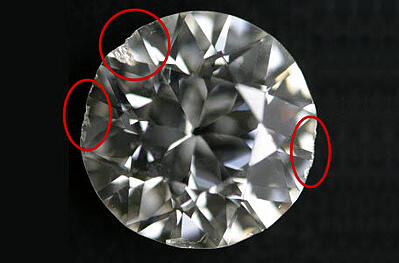The term “off-make” is a trade term used to describe a diamond that has been poorly cut, polished, or finished, resulting in flaws in its overall make. This means the diamond does not meet ideal proportions, symmetry, or polish standards, leading to reduced brilliance, fire, and overall aesthetic appeal.
Characteristics of an Off-Make Diamond
A diamond is considered off-make when it exhibits one or more of the following defects:
1. Poor Proportions
Too deep or too shallow – Affects light reflection and reduces brilliance.
Mismatched angles – Poor crown and pavilion angles lead to light leakage.
Uneven girdle thickness – Some areas may be too thick (wasting carat weight) or too thin (making the diamond vulnerable to chipping).
2. Weak Symmetry
Misaligned facets – When facets are uneven or not placed correctly, the diamond lacks balance.
Table and culet off-center – Affects the diamond’s optical performance and sparkle.
3. Low-Quality Polish
Visible polish lines or marks – Can create a dull appearance.
Rough or grainy surface texture – Reduces light reflection and brilliance.
4. Light Performance Issues
Nailhead effect – The center appears dark due to excessive depth.
Fish-eye effect – A distorted reflection of the girdle inside the table, caused by a shallow pavilion.
Windowing – When light passes straight through the diamond rather than reflecting back, making it appear see-through.
How Off-Make Affects a Diamond’s Value
1. Lower Market Demand
Off-make diamonds are considered less desirable by both jewelers and consumers because they lack brilliance and symmetry.
2. Reduced Sparkle & Fire
A well-cut diamond maximizes brilliance (white light reflection) and fire (color dispersion).
Off-make diamonds often appear lifeless, dull, or dark, even with good clarity and color.
3. Lower Resale & Appraisal Value
Since cut is the most important factor in a diamond’s beauty, a poorly made diamond will be valued lower than a well-cut stone of the same carat weight, clarity, and color.
4. Potential for Weight Retention Over Beauty
Some off-make diamonds are intentionally cut poorly to retain more carat weight from the rough, sacrificing quality for size.
How to Avoid Buying an Off-Make Diamond
1. Check the Cut Grade
Buy diamonds certified by DCLA, GIA, or AGS, which provide cut grades ranging from Excellent to Poor. Avoid stones with Fair or Poor cut grades.
2. Inspect Light Performance
Look at the diamond under different lighting conditions to check for dark areas, weak reflections, or excessive transparency.
3. Look for Proportion Guidelines
Ideal Table Size: 53-58% of the total width
Ideal Depth Percentage: 58-63%
Crown and Pavilion Angles: Well-balanced for optimal light return
4. Use a Loupe or Microscope
Check for symmetry, facet alignment, and polish marks.
5. Ask for an ASET or Ideal Scope Image
These tools reveal light leakage, helping determine if the diamond is well-cut.

